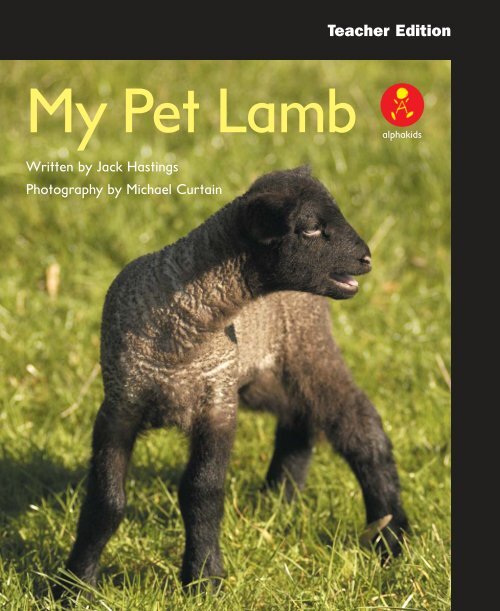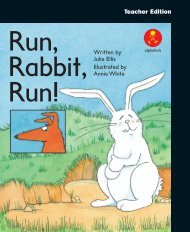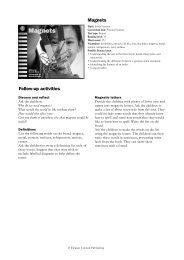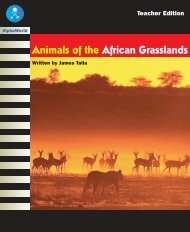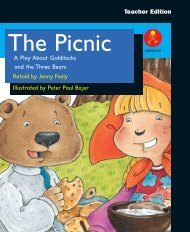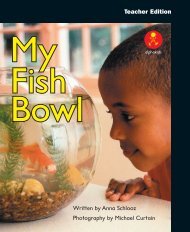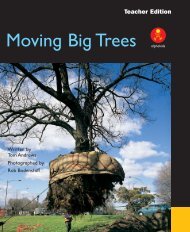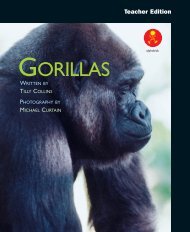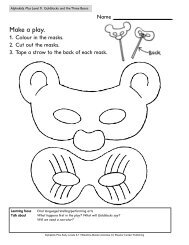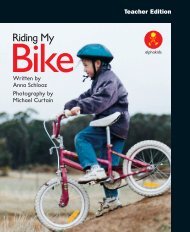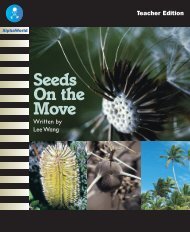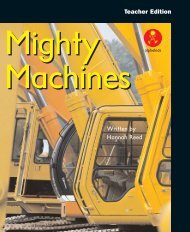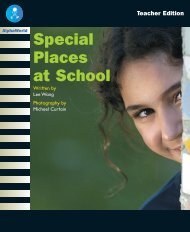L12 TEpp My Pet Lamb
L12 TEpp My Pet Lamb
L12 TEpp My Pet Lamb
You also want an ePaper? Increase the reach of your titles
YUMPU automatically turns print PDFs into web optimized ePapers that Google loves.
Teacher Edition<br />
<strong>My</strong> <strong>Pet</strong> <strong>Lamb</strong><br />
alphakids<br />
Written by Jack Hastings<br />
Photography by Michael Curtain
Horwitz Education<br />
A Division of Horwitz<br />
Publications Pty Ltd<br />
55 Chandos Street<br />
St Leonards NSW 2065<br />
Australia<br />
Horwitz Gardner<br />
Education<br />
Unit 53, Cressex<br />
Enterprise Park<br />
Lincoln Road<br />
High Wycombe,<br />
Bucks, HP12 3RL,<br />
United Kingdom<br />
Published edition<br />
© Eleanor Curtain<br />
Publishing 2003<br />
First published 2003<br />
Apart from any fair dealing for<br />
the purposes of study, research,<br />
criticism or review, as<br />
permitted under the Copyright<br />
Act of Australia, no part of this<br />
book may be reproduced by<br />
any process, or transmitted in<br />
any form, without permission<br />
of the copyright owner. Where<br />
copies of part or the whole of<br />
this book are made under Part<br />
VB of the Copyright Act, the<br />
law requires that records of<br />
such copying be kept and the<br />
copyright owner is entitled to<br />
claim payment.<br />
Developed by<br />
Eleanor Curtain Publishing<br />
Text: Elizabeth Golding<br />
Consultant: Susan Hill<br />
Designed by<br />
Alexander Stitt<br />
Production by<br />
Publishing Solutions<br />
Printed in Hong Kong<br />
ISBN 0 7253 2818 5<br />
Pack ISBN 0 7253 2746 4<br />
(6 Student Books + 1 Teacher<br />
Edition)<br />
1 2 3 4 5 6 7 8 9<br />
03 04 05<br />
?<br />
How to use this book<br />
Before reading: Talkthrough<br />
Talk through the book with the children. Encourage<br />
them to predict the text from the cover and pictures,<br />
and to think about the information they provide.<br />
Direct the children’s attention to aspects of the text<br />
that may challenge them. Support the children to deal<br />
with these challenges by asking the Talkthrough<br />
questions on each page.<br />
During reading: Observe and support<br />
Observe the children as they read. Encourage them to<br />
monitor their own reading as they comprehend the<br />
text. As needed, support children by assisting them to<br />
discover and use reading strategies and cues to solve<br />
problems and respond to reading challenges that arise<br />
in the text. Interruptions to the child’s reading should<br />
be minimal and focused on a specified learning need.<br />
After reading: Comprehension, returning to<br />
the text, responding and writing links<br />
To further develop children’s understanding of the<br />
text, select from activities found on page 12 and the<br />
inside back cover. These whole text, sentence and word<br />
level activities reinforce the teaching focus of this<br />
book. Assessment ideas are provided to assist with<br />
planning for further teaching.<br />
Text highlights<br />
• Displays all the features of a recount<br />
• Written as a temporal sequence<br />
Vocabulary<br />
fence, wrapped, hours, knows
Setting the context<br />
Ask: Have you ever had to<br />
look after a baby animal?<br />
What things did you need to<br />
do? How often did you need<br />
to do these things? What<br />
happened when the animal<br />
grew bigger? Why do baby<br />
animals sometimes need to<br />
be looked after by people?<br />
Background information<br />
Young animals normally<br />
recognise and attach<br />
themselves to members of<br />
the same species. This is<br />
called imprinting. In this<br />
book a lamb imprints itself<br />
on a little boy. The book<br />
recounts how the little boy<br />
cares for the lamb.<br />
Introducing the book<br />
This book is about a boy<br />
who lives on a farm. He<br />
finds a lamb whose mother<br />
has died and he looks after<br />
the lamb. This story tells us<br />
what he does to care for the<br />
lamb.<br />
<strong>My</strong> <strong>Pet</strong> <strong>Lamb</strong><br />
Written by Jack Hastings<br />
Photography by Michael Curtain<br />
alphakids<br />
<strong>My</strong> <strong>Pet</strong> <strong>Lamb</strong><br />
Written by Jack Hastings<br />
Photography by Michael Curtain<br />
alphakids<br />
Front cover<br />
The title of this book is ‘<strong>My</strong> <strong>Pet</strong> <strong>Lamb</strong>’. Who<br />
do you think looks after the lamb? Do you<br />
think that it would be easy to look after a<br />
pet lamb? What do you think that you would<br />
need to do to look after a baby lamb?<br />
Title page<br />
This is the title page. It tells us the name of<br />
the book, and the name of the author and<br />
photographer.<br />
Read the title together.
<strong>My</strong> <strong>Pet</strong> <strong>Lamb</strong> Pages 2–3<br />
?<br />
Talkthrough<br />
Read the text on page 2.<br />
On this page the boy introduces us to the story. He tells us<br />
that he lives on a farm with his family.<br />
Observe and support<br />
Does the child re-read the text to confirm the correct<br />
message?<br />
I like the way that you re-read the text to check that you<br />
understood the message.<br />
2
I live on a farm with my family.<br />
We have cows, goats and sheep.<br />
In winter the sheep have lambs.<br />
2 3<br />
3
<strong>My</strong> <strong>Pet</strong> <strong>Lamb</strong> Pages 4–7<br />
?<br />
Talkthrough<br />
Look at the photographs and read the text on pages 4–5<br />
and pages 6–7.<br />
The boy and his mother go around and check on the lambs<br />
when they are born. They find a lamb that is cold and<br />
hungry. What do you think that they will do with the lamb?<br />
Observe and support<br />
Can the child explain the literal meaning of the text?<br />
Why do they sometimes have to look after a lamb?<br />
4
When the lambs are born, Mum and I<br />
go around and check on them.<br />
Sometimes we have to look after a lamb.<br />
4 5<br />
Last year we found a lamb<br />
whose mother had died.<br />
I could hear the lamb calling<br />
when I woke up.<br />
I found her by the fence, all by herself.<br />
She was cold and hungry.<br />
6 7<br />
5
<strong>My</strong> <strong>Pet</strong> <strong>Lamb</strong> Pages 8–9<br />
?<br />
Talkthrough<br />
Look at the photographs on pages 8–9 and then read<br />
the text.<br />
Now they have to feed and look after the lamb. What do<br />
they feed the lamb? How do you think that the boy feels<br />
about looking after the lamb?<br />
Observe and support<br />
Can the child locate words that indicate past tense in the<br />
text? Ask the child to find words that show that these<br />
events have already happened. (fed, wrapped)<br />
6
We fed her milk from a bottle<br />
and wrapped her in a blanket<br />
to keep her warm.<br />
We fed her every four hours<br />
for the first week and then<br />
three times a day after that.<br />
8 9<br />
7
<strong>My</strong> <strong>Pet</strong> <strong>Lamb</strong> Pages 10–13<br />
?<br />
Talkthrough<br />
Look at the photographs on pages 10–11.<br />
Why does the lamb follow the boy everywhere? How do you<br />
think that the boy would feel about this?<br />
Look at pages 12–13.<br />
When the lamb grew bigger she ate grass and then stayed<br />
with the other sheep. Why do you think that the publisher<br />
included two smaller photographs on page 13?<br />
Observe and support<br />
Can the child read with expression?<br />
Can you make the text sound interesting when you read it?<br />
This makes the text really interesting for others to listen to.<br />
8
She got bigger and stronger every day.<br />
Whenever I went outside<br />
she followed me around.<br />
She thought I was her mother.<br />
10 11<br />
Soon she started to eat grass,<br />
so we stopped feeding her milk.<br />
Then we put her back<br />
with the other sheep.<br />
12 13<br />
9
<strong>My</strong> <strong>Pet</strong> <strong>Lamb</strong> Pages 14–16<br />
?<br />
Talkthrough<br />
Look at pages 14–16.<br />
The lamb has grown into a sheep and has a lamb of her<br />
own. Do you think that she will still know the boy?<br />
Observe and support<br />
Refer to page 15. Can the child recognise the silent letter<br />
at the end of the word ‘lamb’?<br />
What word has a silent letter at the end? Do you know any<br />
other words that have silent letters in them?<br />
10
Now she is as big as the other sheep<br />
and she has a lamb of her own.<br />
14 15<br />
But she still knows me.<br />
16<br />
11
<strong>My</strong> <strong>Pet</strong> <strong>Lamb</strong><br />
Being a meaning maker<br />
Encourage the children to support<br />
their answers with evidence from the<br />
book as they discuss these questions:<br />
What did the boy do to look after the<br />
lamb?<br />
Why did the lamb think that the boy<br />
was her mother?<br />
Why did the boy put the lamb back into<br />
the paddock with the other sheep?<br />
What other ways might this boy look<br />
after animals on the farm?<br />
Being a text user<br />
What kind of book is this? Fiction or<br />
information? How do you know?<br />
What could you learn about looking<br />
after lambs by reading this book?<br />
Being a text critic<br />
What did the author need to know<br />
about to write this book?<br />
Do all children get to raise pet lambs?<br />
Being a code breaker<br />
Explore the following language<br />
features:<br />
• Spelling pattern used to represent<br />
the sound /m/ as in lamb: bomb,<br />
comb, dumb, tomb, thumb.<br />
12
Responding to text<br />
Borrow other fiction books such<br />
as ‘Sebastian Lives In a Hat’ by<br />
Thelma Catterwell, and information<br />
books about raising baby animals for<br />
children to learn more about this<br />
topic.<br />
Draw story maps of ‘<strong>My</strong> <strong>Pet</strong><br />
<strong>Lamb</strong>’ showing the main<br />
sequence of events. Include<br />
statements about each of the main<br />
events.<br />
Investigate how spelling relates<br />
to tense: found, died, hear, fed,<br />
wrapped, followed, thought, started,<br />
stopped.<br />
Writing links<br />
Modelled writing<br />
Ask children to recall the sequence of<br />
events in the story. As children share<br />
each segment, list this information in<br />
point form, so children can see the<br />
importance of planning their writing.<br />
Shared/guided writing<br />
Using the above planning idea,<br />
children work with a partner to plan<br />
and write about a time that they<br />
raised a baby animal. Stress to<br />
children that they are writing a<br />
recount like ‘<strong>My</strong> <strong>Pet</strong> <strong>Lamb</strong>’ and that<br />
the events occur in order (temporal<br />
sequence). Children could make this<br />
into a picture story book just like ‘<strong>My</strong><br />
<strong>Pet</strong> <strong>Lamb</strong>’.<br />
Assessment<br />
Can the child:<br />
• Identify that the book is factual and is a recount?<br />
• Retell the events in the book in the correct order?<br />
• Identify words that indicate an event happened in the past?<br />
whole text activity sentence activity word activity
<strong>My</strong> <strong>Pet</strong> <strong>Lamb</strong><br />
Written by Jack Hastings<br />
Photography by Michael Curtain<br />
alphakids<br />
Teacher<br />
Edition<br />
Other books<br />
at this level<br />
Looking Like<br />
Plants<br />
alphakids<br />
Written by Hannah Reed<br />
Photography by Gary Lewis<br />
Topic: Living things<br />
Curriculum link: Science<br />
Text type: Recount<br />
Reading level: 12<br />
Word count: 175<br />
Vocabulary: fence, wrapped, hours, knows<br />
Treasure<br />
Hunt<br />
Written<br />
by Jack Hastings<br />
Photography by Michael Curtain<br />
alphakids<br />
Let’s Make<br />
Pancakes<br />
alphakids<br />
Written by Emma Rossi<br />
Photography by Michael Curtain<br />
Possible literacy focus<br />
Exploring the features of a recount.<br />
Retelling a temporal sequence.<br />
Investigating words that indicate past tense.<br />
Don’t Worry!<br />
Written by Christopher Stitt Illustrated by Steve Axelsen<br />
alphakids<br />
Mice In Space<br />
Starring Max and Matilda Mouse<br />
alphakids<br />
Summary<br />
This book is a recount about how a young boy<br />
raises an orphaned lamb on his farm. The book<br />
provides information about what he does to care<br />
for the lamb.<br />
Written<br />
and illustrated<br />
by Alex Stitt<br />
ISBN 0- 7253- 2818- 5<br />
alphakids<br />
9 780725 328184


